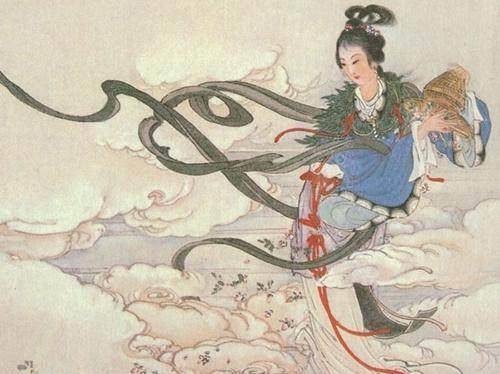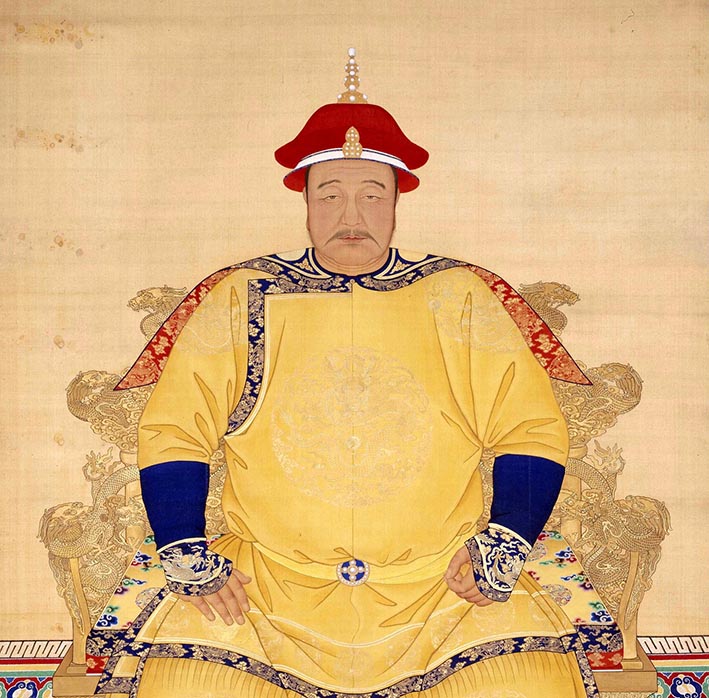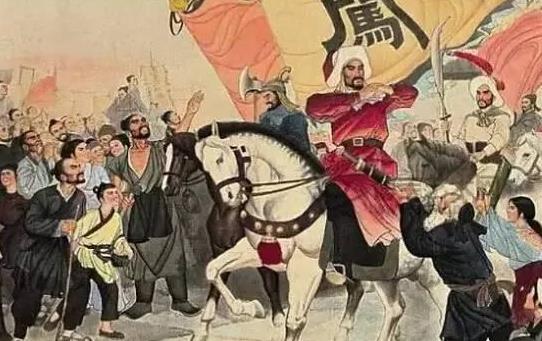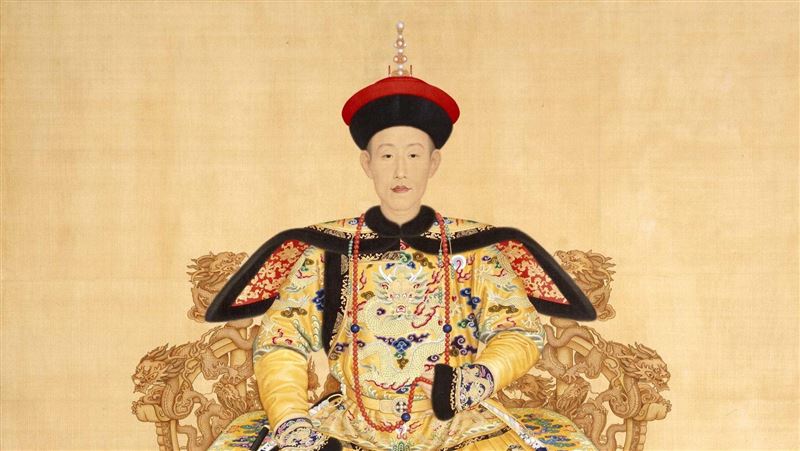Introduction
Since the establishment of the first Chinese dynasties, incursions by the peoples inhabiting the northern steppes have always constituted a central problem in the politics of successive states. These peoples, of different ethnicities, were mostly nomads engaged in herding and hunting, skilled horsemen and archers who, we could almost say, were born on horseback.

Manchu archer on horseback.
Considered as barbarians by the Chinese and very different from them in their social and political structures, as well as in their culture and way of life, these peoples were not organized into states but rather into mobile tribes and tribal confederations, which would unite or dissolve based on their needs and mutual relationships.
Depending on the land's resources for their subsistence, during drought seasons or periods of famine, they had no alternative but to look southward and engage in pillaging and looting of the sedentary villages on the northern frontier of the Chinese Empire.
At times, these tribes, often divided and at odds with each other, managed to organize under a single ruler or Khan and, instead of merely engaging in raiding incursions, embarked on territorial conquest. On several occasions between the 10th and 13th centuries, they succeeded in asserting dominance and establishing dynasties that ruled over a greater or lesser part of the Chinese territory.
Such is the case of the establishment of the Liáo 遼 Dynasty by the Khitan (qìdān 契丹) in the 10th century, the Jīn 金 Dynasty by the Jurchen (nǚzhēn 女真) in the 12th century, and the Yuán 元 Dynasty by the Mongols, descendants of Genghis Khan, in the 13th century.
All of these dynasties lasted for a relatively short time. However, in the 17th century, the Manchus (mǎnzú 滿族), descendants of the Jurchen, conquered China and established a new dynasty that would last nearly three hundred years, expand the empire to more than twice its previous size, and lay the foundations of modern China: the Qīng 清 Dynasty.
The acculturation of the "barbarian" peoples
The establishment of each of these "foreign" dynasties, as they are sometimes referred to, had a significant impact on Chinese cultural practices, ranging from food and clothing to government institutions. However, and perhaps to an even greater extent, these "barbarian" peoples were transformed by the culture of their Chinese subjects in a process of acculturation known as "sinicization".
This acculturation of foreign peoples was perhaps a result not only of China's great cultural influence but also of the need to govern as a minority.
To give you an idea, during the Qīng Dynasty, the Manchus constituted only 0.4% of the population, which means there was one Manchu for every 250 Hàn 漢 Chinese. With such numbers, military control was not feasible, and it was necessary to rely on the Chinese civil administration by establishing power compromises between the Manchus and the local elite of officials and literati.
Origins of the Manchus
The region currently known as Manchuria (in Chinese, Dōngběi Píngyuán 东北平原) encompasses the northeastern part of present-day China, between Korea, Siberia and Mongolia. In this region, in the 16th century, resided the descendants of the Jurchen, a Tungusic people who had established the Jīn Dynasty in northern China in the 12th century.
After the fall of the Jīn Dynasty a century later, many Jurchen descendants returned to their ancestral land. In the 14th century, this region came under the military control of the Míng 明 Dynasty. Its inhabitants were not nomads but rather farmers who lived in villages with a simple economy.
Foundational myth
According to the foundational myth of the Manchu people, a maiden named Fekulen (Fúkùlún 佛庫倫) descended from the heavens and bathed in a lake in the Chángbái Mountains 長白山, which border the Korean Peninsula with present-day China. After finishing her bath and preparing to dress, she found a red fruit on her clothes, and upon eating it, she immediately became pregnant.

Fekulen (Fúkùlún 佛庫倫).
In this way, she gave birth to a child named Bukūri Yongšon (Bùkùlǐ Yōngshùn 布庫里雍順), who was born with the ability to speak and possessed supernatural powers. Before returning to the heavens, his mother placed him in a small boat on the river and sent him downstream to a village called Odoli (Áodōng 敖東), with the mission of bringing peace to its inhabitants.
Upon arriving in the village of Odoli, Bukūri Yongšon was welcomed by its people, who made him their prince. He and his descendants ruled the area, maintaining peace for many generations.
However, over time, the power wielded by the descendants of Bukūri Yongšon became violent once again and led to a rebellion. The soldiers killed all members of the clan, except for a young man named Fanca (Fànchá 範察), who managed to escape with the help of a magpie, the totemic animal of the Manchu people.
Even today, the Manchu people call themselves Chángbái lǎorén 長白老人 ("elders of the Chángbái Mountains"), and Fanca is considered the ancestor of the founders of the Qīng Dynasty.

Chángbái Mountains 長白山.
Although this is a legend, there are records of a Jurchen named Fanca who, in 1412, moved with his people from the Chángbái Mountains to settle in Hetu Ala (Hètú'ālā 赫圖阿拉), where the Qīng dynasty began. Indeed, among the descendants of this Fanca is Nurhaci (Nǔ'ěrhāchì 努爾哈赤), considered the founder of the Qīng Dynasty.
In the 15th century, the Jurchen of Jiànzhōu 建州 (Jiànzhōu nǚzhēn 建州女真) resided in this region, divided into three feuding branches. Fanca pledged allegiance to the Míng Dynasty and became the leader of one of these branches, with his descendants inheriting this position for over a century.
Beginnings in power
At the end of the 14th century, the region now known as Manchuria, inhabited by the Jurchen, fell under the rule of the Míng Dynasty (1368-1644), which established a military administration.
The tribes residing in the region were settled in small villages and paid tribute to the Míng court, whose rulers fostered divisions among their factions to prevent potential rebellions.
In the mid-16th century, violence erupted among the different factions of the Jurchen. The Míng forces intervened in support of one of these groups. However, a few years later, while fighting a common enemy, they killed their leaders and claimed it was an accident. These leaders happened to be the father and grandfather of Nurhaci.
Although the death of his father weakened Nurhaci's position, over the years he emerged as a dominant figure among the Jurchen, who united under his leadership into a single political and military entity.
Initially, Nurhaci remained loyal to the Míng Dynasty, but eventually he rebelled and established the Later Jīn Dynasty (Hòu Jīn Guó 後金國) in the region controlled by the Jurchen. He claimed legitimacy and direct lineage from the earlier Jīn Dynasty of the 12th century.
Nurhaci passed away in 1626, and it was his eighth son, Hong Taiji (Huáng Tàijí 皇太極), who was chosen as his successor based on his merits and capabilities. Hong Taiji consolidated the Later Jīn state and adopted many institutions and a significant portion of the bureaucratic system from the Míng Dynasty.

Hong Taiji (Huáng Tàijí 皇太極).
In 1635 Hong Taiji renamed the Jurchen people Manju or Manchu (Mǎnzú 滿族), proclaiming that this was their original name and that they would be called that way from that time on. This denomination was a way to camouflage the rivalries between the different Jurchen factions and unite them into a single collective identity.
The following year he also renamed the state he ruled, abandoning the name of Later Jīn given by his father, and renaming it Dà Qīng 大清, which in Chinese means "Great Pure".
Hong Taiji claimed the Mandate of Heaven (Tiānmìng 天命), thus legitimizing his aspirations to rule China. The water radical of the Qīng character symbolizes the extinction of fire, which is implicit in the name of the Míng dynasty. However, Hong Taiji died without having achieved his aspirations.
The fall of the Míng and the conquest of China
Upon Hong Taiji's death in 1643, the Manchus chose one of his sons, Fulin (Fúlín 福臨), as heir. Fulin, who reigned under the name Shùnzhì 順治, was only five years old at the time, and it was decided that a prince named Dorgon (Duō'ěrgǔn 多爾袞) would take over the government until Fulin came of age.
Meanwhile, in Míng China, and for several years now, a peasant rebellion led by an aggrieved official, Lǐ Zìchéng 李自成, gained followers among the population. In April 1644, Lǐ Zìchéng took Běijīng 北京. On the eve of defeat, the Míng emperor committed suicide by hanging himself, and the rest of the court fled south.

At the same time that all this was happening, in the north, the Manchus led by Dorgon were in negotiations with the Míng general in charge of keeping the Shānhǎi pass (Shānhǎi Guān 山海關), in the Great Wall. This general, Wú Sānguì 吳三桂, agreed to open the gates of the Great Wall to the Manchus in exchange for their help in crushing Lǐ Zìchéng's rebellion and re-establishing the Míng dynasty.
The Manchu army clashes with Lǐ Zìchéng's troops east of Běijīng, crushing them, although their leader managed to escape. However, after the victory, and contrary to the agreement with Wú Sānguì, the Manchus entered the capital and declared themselves the new masters of the empire, formally establishing the Qīng dynasty in June 1644.
A year later, Lǐ Zìchéng was finally cornered and killed. That same year, the Manchus crossed the Yellow River (Huáng Hé 黄河) and, in the following years, conquered the rest of China. Most of the cities surrendered to them without a fight, although some enclaves resisted. This was the case of Yángzhōu 揚州, where the Manchus made a great carnage after taking the city by force.
Meanwhile, the rest of the Míng court had escaped south, where they established the so-called Southern Míng dynasty (Nán Míng 南明), which lasted until 1661, when Wú Sānguì himself, in the service of the Manchu, captured and killed them in Burma.

General Wú Sānguì 吳三桂.
The challenges of governing China
The sudden conquest of China by the Manchus was a severe blow to the Hàn population, who were forced to choose between submitting to the new order, rebelling or withdrawing from society by entering a monastery or a hermitage.
The new rulers imposed the biànzi 辮子, the Manchu braid, as a symbol of submission to all their male subjects. We have already talked about the rejection that this measure provoked (see The Imposition of the Bianzi, the Manchu Queue), so we will not dwell on it again here.

Biànzi 辮子 or Manchu queue.
But the Manchus, in order to rule as a minority, also needed to get the local population on their side, especially the civil elite of officials, literati and administrators, so that the government bureaucracy could continue to function.
To do this, they had to legitimize themselves in the eyes of their subjects by upholding the Confucian values that had formed the foundations of Chinese society for about two millennia. In this way, the change of dynasty did not mean a rupture of social values and intellectual tendencies, but a continuation of these.
Most of the Hàn Chinese considered the Manchus a barbarian people, and found it difficult to be ruled by those they considered inferior. One of the most important factors that allowed the Manchus to remain in power, being in a minority of one to 250, was undoubtedly their ability to find a compromise between Chinese Confucian values and their own Manchu identity. And we can consider that they achieved it quite successfully, judging by the almost three centuries that their rule lasted.
However, the dynasty also faced rebellions. The first of these, that of Wú Sānguì himself, which was about to end their reign. The suppression of this rebellion, known as the Three Feudatory Rebellion (Sānfān zhī luàn 三藩之亂), marked the beginning of a long era of loyalty to the new dynasty. The next major rebellion did not occur until two centuries later, the Tàipíng Rebellion (Tàipíng tiānguó yùndòng 太平天國運動).
Although the Qīng dynasty does not enjoy a good reputation in Chinese history, the truth is that its first hundred and fifty years were a golden age of economic and population growth, as well as cultural flourishing. At this time the two emperors with the longest reigns in China's long imperial history occupied the throne: Kāngxī 康熙 and Qiánlóng 乾隆. These emperors were great patrons of Chinese culture and promoters of traditional arts such as calligraphy and painting.

The Kāngxī 康熙 Emperor.

Qiánlóng 乾隆.
A perpetual problem faced by these rulers was how to retain their Manchu identity in a Chinese world, following Chinese customs and making use of Chinese institutions.
In the nineteenth century, most Manchus had shed the cultural traits that at the beginning of the dynasty identified them as such: they had abandoned the Manchu language, adopted Chinese names, did not know how to ride a horse or shoot with a bow, and practiced Chinese cultural arts such as poetry, painting or calligraphy.
Despite this, they retained other traits that unmistakably distinguished them from the rest of the Chinese, such as a strong northern accent, practiced their ancestral shamanic religion, their women did not bind their feet and wore three pairs of earrings, and lived in separate cantonments.

Manchu women.
Conclusions
The Qīng dynasty enjoys, in Chinese popular culture, a questionable reputation. It is said that it was a corrupt dynasty that oppressed the people and had numerous opponents. Although it is true that the Manchus enjoyed legal privileges, the corruption of their rulers and the opposition of the people are events much later than their coming to power.
The Manchus, as already explained, would never have been able to rule such a great Chinese population if they had not had the support of a large part of them and the social elite. The aforementioned Kāngxī and Qiánlóng, as well as Yōngzhèng 雍正, are among the best and most dedicated emperors in all of Chinese history. Under their rule, China lived a time of splendor and economic prosperity and was among the most advanced nations in the world. Under Qiánlóng, the Qīng empire extended its territory to almost three times its previous extent, shaping the boundaries of present-day China.
It was towards the end of Qiánlóng's reign that this situation began to change. Massive corruption spread in the last two decades of the eighteenth century. The most famous corruption case in the entire history of the country was that of Niohuru Hesen (Niǔhùlù Héshēn 鈕祜祿和珅), a government official who throughout his life accumulated more wealth than the emperor himself.
The end of Qiánlóng's reign marked the beginning of a period of decline that culminated in the nineteenth century, during the Opium Wars (Yāpiàn Zhànzhēng 鴉片戰爭). The anti-Manchu sentiment that spread at that time was largely the result of the propaganda of the Tàipíng Rebellion and the Chinese nationalism of the late dynasty.
